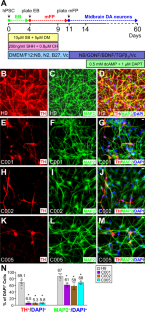2022-06-09 バッファロー大学(UB)
「これらのニューロンは、他のニューロンからの興奮性入力に関係なく、活動電位を連続的に発射するペースメーカーです。このペースメーカーとしての特性は、神経細胞の機能にとって非常に重要であり、パーキンソン病における神経細胞の脆弱性の根底にあるものです。」UBの健康科学担当副学長兼ジェイコブス学部長のアリソン・ブラッシャー医学博士は、「このエキサイティングなブレークスルーは、パーキンソン病とその治療法をより良く理解するための努力に不可欠な前進です」と語っています。
<関連情報>
- https://www.buffalo.edu/news/releases/2022/06/010.html
- https://www.nature.com/articles/s41380-022-01628-1
人工多能性幹細胞からのヒトA9ドーパミン作動性ペースメーカーの作製 Generation of human A9 dopaminergic pacemakers from induced pluripotent stem cells
Hong Li,Houbo Jiang,Hanqin Li,Li Li,Zhen Yan & Jian Feng
Molecular Psychiatry Published:24 May 2022
DOI:https://doi.org/10.1038/s41380-022-01628-1

Abstract
The degeneration of nigral (A9) dopaminergic (DA) neurons causes motor symptoms in Parkinson’s disease (PD). We use small-molecule compounds to direct the differentiation of human induced pluripotent stem cells (iPSCs) to A9 DA neurons that share many important properties with their in vivo counterparts. The method generates a large percentage of TH+ neurons that express appropriate A9 markers, such as GIRK2 and ALDH1A1, but mostly not the A10 marker CALBINDIN. Functionally, they exhibit autonomous pacemaking based on L-type voltage-dependent Ca2+ channels and show autoreceptor-dependent regulation of dopamine release. When transplanted in the striatum of 6-OHDA-lesioned athymic rats, the human A9 DA neurons manifest robust survival and axon outgrowth, and ameliorate motor deficits in the rat PD model. The ability to generate patient-specific A9 DA autonomous pacemakers will significantly improve PD research and facilitate the development of disease-modifying therapies.


